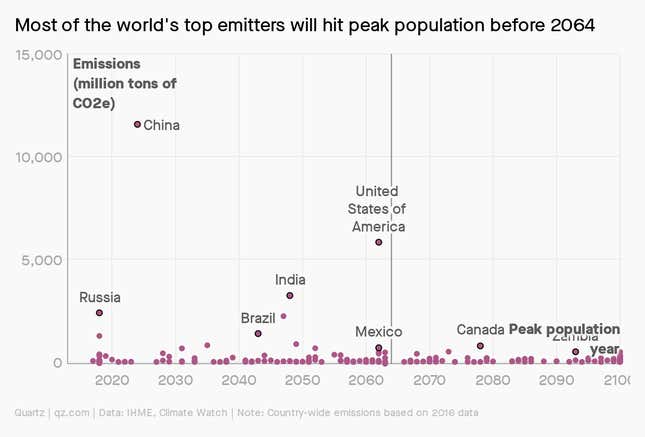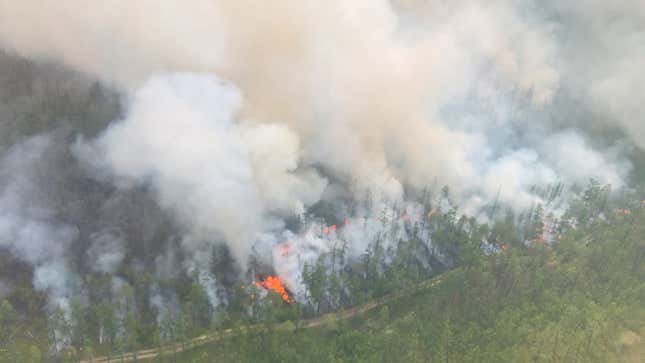Could a falling global population be part of the solution to climate change?
That’s what we wondered when we read a new global population projection published this month in The Lancet by a team of public health researchers at the University of Washington. The paper includes detailed population estimates for every country between now and 2100. The takeaway is that globally, fertility is falling fast: The world’s population is expected to peak in 2064, at 9.73 billion.
That’s a bit late to help the planet reach its near-term climate goals, including the all-important target of net zero global emissions by 2050. Still, population growth is a key variable in any study of future climate impacts, from rising sea levels to food insecurity. And a closer look at local fertility projections can help us prepare for the challenge ahead.
One intriguing trend that stood out to us in the data: For the most part, countries with bigger carbon footprints will hit peak population earlier than average, many before 2050.

China, for example, is expected to reach peak population in 2024. (The US is an exception among super-emitters, peaking in 2062, in part due to large volumes of immigration.) This isn’t too surprising. Richer countries tend to emit more, and also to have higher levels of education for girls and better access to birth control—the two most important factors in limiting population growth.
As the major drivers of the clean energy market, these countries bear the greatest burden to ensure that global per-capita emissions don’t increase, even as their own populations fall.
But it also means that some of the countries most vulnerable to and least equipped to manage climate impacts will see their populations grow all the way through the end of the century—Niger, the Democratic Republic of Congo, Chad, and Somalia among them. What kind of world they’ll have then is still up to us.
✦ You can read more about the effects of a plummeting birth rate on climate change by signing up for a Quartz membership. ✦

Here’s what happened over the past week that helped or harmed the world’s chances of cutting greenhouse-gas emissions to zero:
Decreases emissions
1️⃣ Floating wind farms are fully operational. A 25MW offshore wind farm off the coast of Portugal is now sending electricity at full capacity to the nation’s power grid.
2️⃣ Swiss insurance giant Zurich canceled a $508 million policy covering Canada’s Trans Mountain oil pipeline carrying crude from Alberta’s oil sands to ports in British Columbia.
3️⃣ Data center firm Switch will host a 240-megawatt-hour Tesla battery next to a solar farm in Nevada. It’s the largest customer-sited storage project of its kind, a model that may catch on.
Net-zero (for now)
1️⃣ Apple says all its products and supply chain will be carbon-neutral by 2030. Its greenhouse gas emissions will be cut by 75%, while carbon removal from forests and “nature-based solutions” will eliminate the remainder.
2️⃣ The UK government removed barriers to build huge energy storage projects in England and Wales. But a cheaper solution to power the grid might be to plug into the coming wave of electric vehicles.
3️⃣ The US will now fund nuclear power projects abroad to encourage developing countries to embrace the carbon-free power source. Critics say the foreign policy gambit will harm anti-nuclear proliferation efforts.

🔼 Increases emissions
1️⃣ The Arctic is burning, again. Temperatures in Siberia rose 10 degrees Celsius (18 Fahrenheit) above average in June, and hit 38 C (100.4 F) in the Russian town of Verkhoyansk.
2️⃣ US oil companies are staggering back after output fell 25% in June from 13 million barrels per day at the start of the year. The country’s production should stabilize about 11 million barrels daily through 2020, a share of global production that acts as a ceiling on oil prices.
3️⃣ New York City is now subtropical, declares The New York Times, as northern climes rapidly warm due to greenhouse gas emissions. In the botanical gardens, the state flower of Alabama, the camellia, is now blooming successfully.
Additional reporting by Michael Coren.
Stats to remember
As of July 26, the concentration of carbon dioxide in the atmosphere was 413.11 ppm. A year ago, the level was 411.07 ppm.
Have a great week ahead. Please send feedback and tips to tmcdonnell@qz.com and mjc@qz.com.